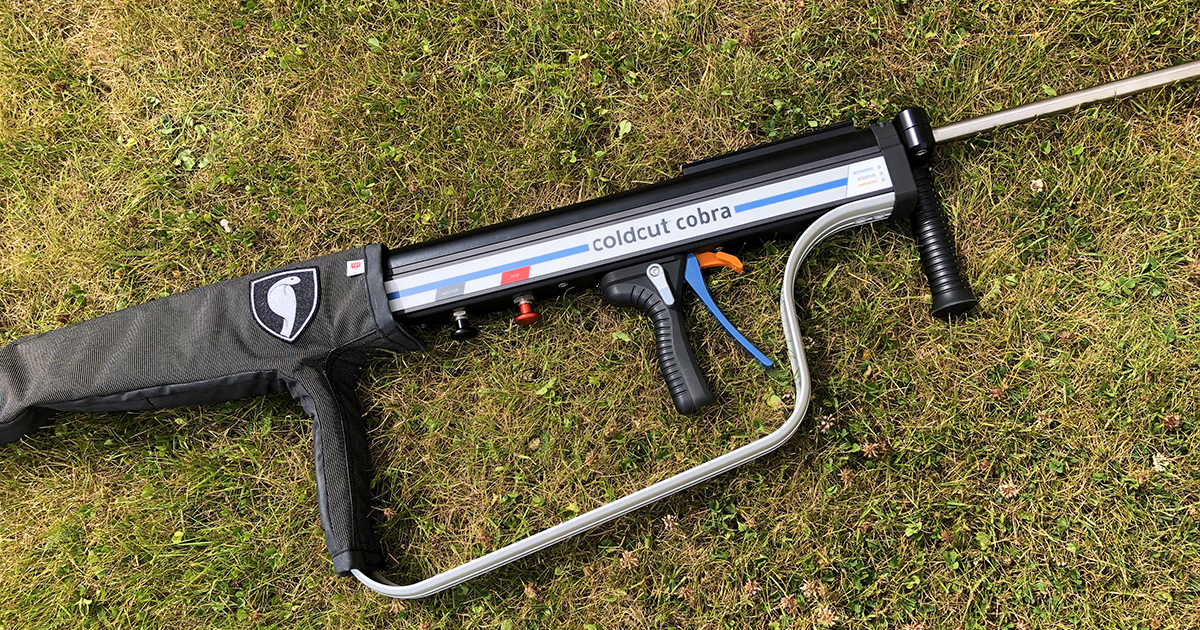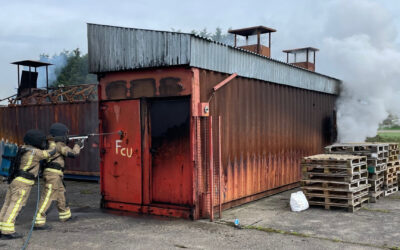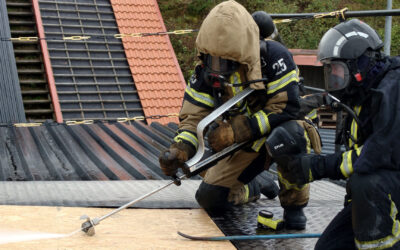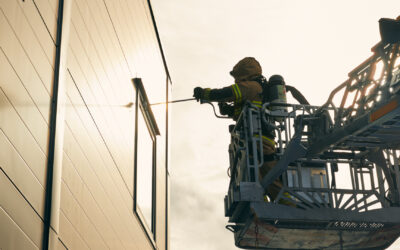To get the great cutting effect and still have a manageable tool to work with, you need to add a cutting agent into the high-pressure water line. In general, cutting extinguishers use two different ways to do this; through a suspension system or an entrainment system. But what is the difference between the two technical solutions?
A high-pressure water jet alone can pierce construction material such as tiles, concrete, and lumber. But to cut steel or reinforced concrete, for example, a much higher pressure of around 7 000-10 000 bar is required. Such high pressure is difficult to obtain and use. By adding abrasive, a cutting agent, to the water jet, it is possible to significantly improve the performance of the jet at a lower pressure of about 200-300 bar.
Cold Cut Systems use an abrasive made from olivine – a naturally occurring residue of ore mining, hence 100% environmentally friendly.
In general, there are two ways of introducing a cutting agent into the high-pressure water line; through a suspension system or an entrainment system.
Suspension system
A suspension system, to which Cobra belongs, introduces the abrasive to the water line after the high-pressure pump but before the hand lance. Through a control system, the hand lance operator will call for abrasive from an abrasive vessel. The abrasive travels from the vessel through the hose with a velocity of 5 m/s and exits through the nozzle of the hand lance.
The most common Cobra system fits a 10 litres abrasive vessel on a 60 litres per minute system, which generates at least 4 minutes of piercing. Replenishing of abrasive is done at the abrasive vessel, for instance, by the pump operator.
Entrainment system
An entrainment system carries the abrasive vessel on the hand lance and introduces the abrasive at the hand lance. It works as a water blaster; as the water passes through the first nozzle in the hand lance into a venturi chamber, a certain degree of vacuum is created, and the abrasive material is sucked into the water stream and accelerated through the second nozzle. The diameter of the second nozzle is two to three times the first, giving up to a nine times as large area of the second nozzle. This will in turn affect the area of the hole to be pierced, thus the amount of abrasive used.
When the water jet passes through the venturi chamber turbulence is created because of the pressure drop, hence the introduction of the abrasive has a reducing impact on the speed of the water – affecting both the water jet speed and the water droplet distribution negatively. This implicates that the entrainment system will use at least four times as much abrasive to penetrate the same object as a suspension system; and, to get the same water droplet distribution, the nozzle has to be changed to one without a venturi chamber once the hole is pierced.
A firefighter already carries a load of about 20 kg when wearing full PPE, in addition, according to Swedish working regulations (AFS 2012:2), manual lifting of more than 25 kg should not occur. Therefore, the lighter the additional equipment the better. A hand lance with suspension system is generally lighter than an entrainment hand lance, since the abrasive supply is on the vehicle, no extra weight is added to the suspension hand lance – the Cobra lance weighs 4.6 kg for instance. Whereas a hand lance with entrainment system carries more load on the hand lance as the abrasive supply is directly connected to it. An entrainment hand lance weighs about twice the amount of a suspension hand lance – and that is without abrasive container.
For ergonomic reasons, an entrainment hand lance may not have more than two kilos of abrasives in the bottle attached. This means that after 30s of piercing, the operator has to stop the operation to change the abrasive bottle. This in turn means that the operator must have a logistic support set up to transport abrasives from a rear supply to the scene of the fire. This requires more personnel and hence adds extensive risks.
Comparison between the system
The Belgian agency IBZ has carried out a tender comparison between a suspension system and an entrainment system. Among other things, they compared the penetration time through a 5 mm mild steel plate. For the suspension system it took 7.8 seconds and for the entrainment system it took 29 seconds. The amount of abrasive used per minute differed as well – 0.36 kg/min for a suspension system and 1.18 kg/min for an entrainment system. The conclusion is that a suspension system is lighter (6 kg to 14 kg), faster (even if you have to include filling an 80-meter hose) and consumes less abrasive (even if you have to fill an 80-meter hose) than an entrainment system.
To read more:
“Ergonomics for the Prevention of Musculoskeletal Disorders“ (AFS 2012:2)
Federale Overheidsdienst Binnenlandse Zaken, IBZ. (2014). Bestek (and) Gemotiveerde beslissing.
Tian, S., Li, G., Huang, Z., Song, X., Sheng, M. & Shah, S. (2018). Abrasive Water Jet Perforation and Multi-Stage Fracturing. Gulf Professional Publishing.



